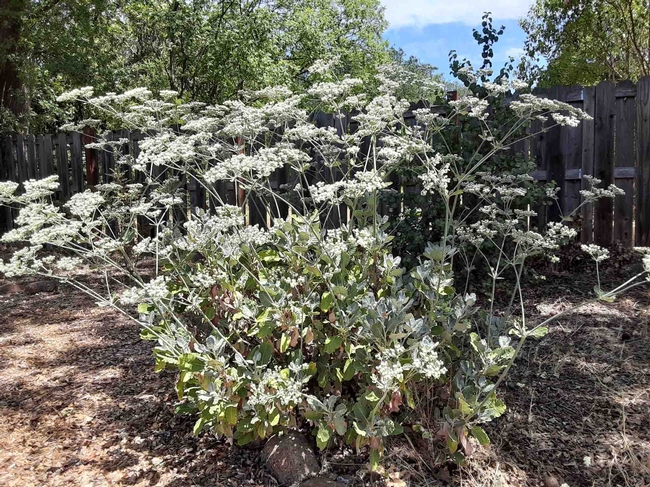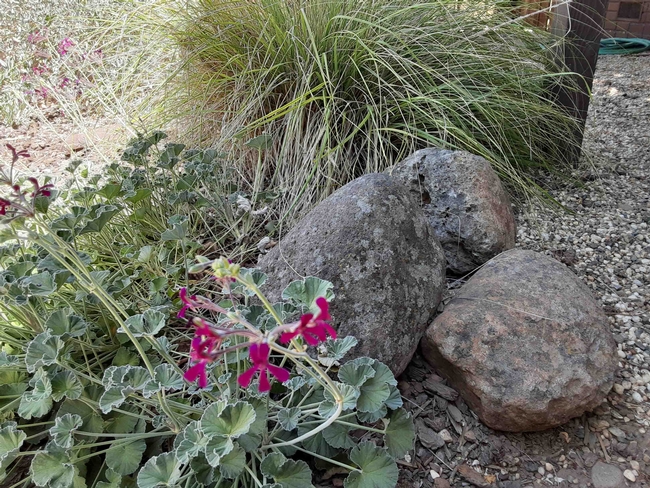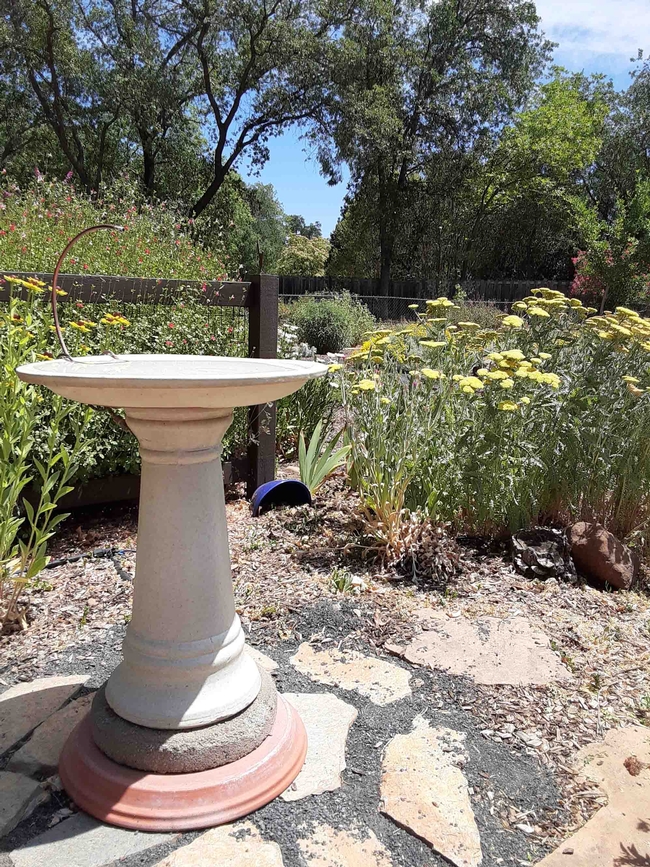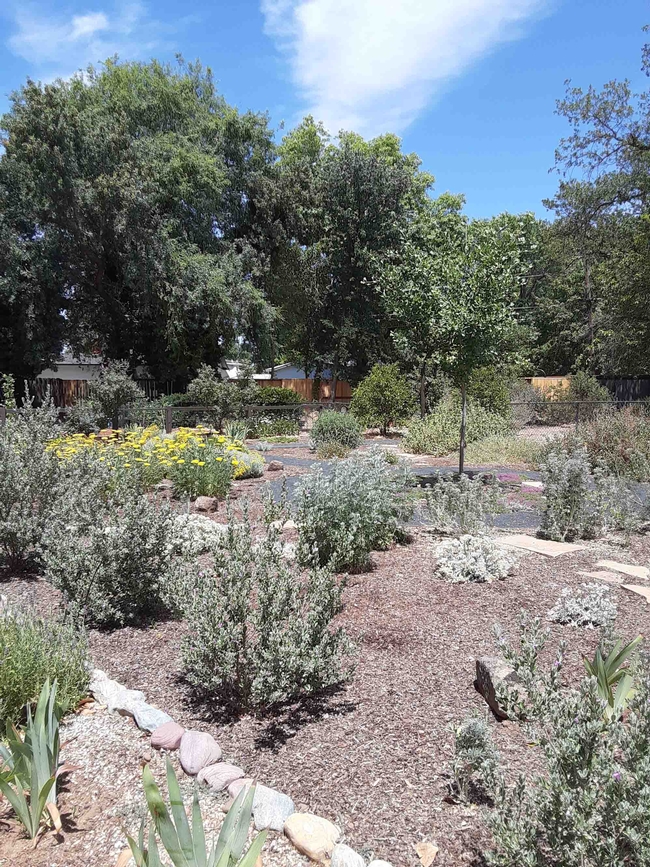While you might not be able to save them all, you can take precautions in your garden that will save the plants it makes sense to save, define your gardening priorities, and plan for continuing drought conditions in our Northern California Mediterranean climate. When drought conditions are prolonged, landscape plants, trees, and lawns may suffer temporary or permanent damage. The information presented here is designed to help you make the right decisions for watering and managing your landscape when Mother Nature turns the spigot off.
Plants are like water pumps, drawing in moisture from the soil that is used for plant growth and releasing water from stems and leaves through a process called transpiration. Plants wilt and suffer drought stress when transpiration exceeds water uptake.

- Wilting leaves that do not improve in the evening
- Yellowing and upward curling or rolling of leaves
- Leaf, blossom, and fruit drop
- Browning or scorching of leaf margins and tips
- Under-sized and off-flavored fruits, vegetables, and nuts
- Small leaves; limited shoot growth
- Interior needle and leaf drop on conifers and evergreens
- Lawn grasses that retain a footprint for several minutes
Secondary problems associated with drought:
- Spider mite infestations
- Blossom-end rot of tomatoes, peppers, squash, and melons
- Wildlife feeding on irrigated fruits and vegetables
- Increased damage by insects (e.g. grasshoppers) driven into home landscapes by a lack of food and water
- Increased susceptibility to sunburn and attack by insect borers
Long-term consequences of drought:
- Branch dieback on trees (loss of shade and costly pruning or tree removal)
- Diminished winter hardiness
- Increased plant disease susceptibility
- Root death and eventual plant or tree death
Prioritize Your Plants
In terms of existing landscapes, first determine which plants in your garden are most susceptible to water stress and are of most value to you. High on your watering list might be plants that are valuable in terms of replacement cost, or that you enjoy and have prominence in the landscape. Below is a rating system for prioritizing the water needs of typical landscape plants:
High Priority -trees and shrubs, especially large, mature shade trees and shrubs.

Low priority - annual flower and herb plants, ornamental grasses, established turf, and seasonal vegetable gardens. These are relatively inexpensive and more easily replaced. It may be difficult to keep large beds of annuals adequately watered during a drought.
Cultural Tips
- Mulch around plants to control weeds, conserve soil moisture, and moderate soil temperatures. Organic mulches, such as bark, shredded leaves, grass clippings, and straw are preferred because they improve soil structure and return nutrients to the soil upon decomposition. Apply mulches from 2 to 4 inches deep. Do not place mulch directly on top of plant crowns or too close to the trunk or stems of your plants, since a layer of mulch can cause the crown to rot.
- Avoid using fertilizers or pesticides. Fertilizers can damage root systems under drought conditions and pesticides may burn plant foliage.
- Resist the temptation to prune woody ornamentals, and fruit and nut trees. Some drought-stressed plants may go dormant and appear dead. Dead wood is brittle and brown under the bark and dormant wood is white or green under the bark. Wood that is obviously dead may be removed at any time.
- Keep foot and equipment traffic to a minimum on dormant turf. Turfgrass crowns become brittle during drought and are more easily damaged by compaction.
- Keep turf at least 2 feet from the trunks of young or newly planted trees to reduce competition with the trees for water. Apply mulch in this area.
- Control weeds around shrubs, vegetables, and flowers. Weeds compete with cultivated garden plants for water and nutrients.
- When dusty, spray plant foliage with water to wash off and reduce spider mite populations. Don't spray water on plants in the direct hot sun.
- After the drought passes, replace declining or dead plants with others that are hardier and drought tolerant (new plantings require regular watering).
- Leave shallow pans of fresh water out for wildlife and beneficial insects. Keep birdbaths filled with fresh, clean water.
- When possible, incorporate organic matter into soil since this improves the soil's water-holding capacity and promotes good drainage during wet weather.

Water your garden in the early morning to minimize fungal diseases and water loss to evaporation.
Ornamental Trees and Shrubs: Thorough deep irrigations a week or two apart in summer will often keep these valued plants alive through summer, especially if soils and roots are relatively deep. Shallow soils (foothills and the east side of Chico) will require closer intervals between irrigations. Most well-established trees and shrubs can survive stretching out the period between irrigations as long as they are thoroughly watered when irrigation is applied. If you cut off irrigation to a lawn, shrubs and trees that have been dependent on regular lawn watering must have supplemental irrigation of their own to prevent limb dieback and tree death. Following water stress, birch, ash, and redwoods are especially susceptible to dieback and the subsequent need for costly pruning.
Fruit and Nut Trees: Keeping fruit and nut trees alive during severe water shortages is also possible by stretching out the interval between irrigations. When trees are stressed, fruit set may be reduced, heavier fruit drop may occur, and fruit size will be smaller. This can be partially offset by heavier fruit thinning in the spring. To produce a good crop, deciduous fruit and nut trees need adequate water in their root zones continuously from bloom until harvest. Severe stress resulting in leaf loss during summer will reduce bloom the following season and can result in sunburn of limbs, borer attacks, and branch dieback. Citrus trees need adequate soil moisture during spring to set fruit and steady water in summer and fall to produce acceptable size, numbers, and quality of fruit.

Vegetables: Vegetables are difficult to maintain during a drought. Tomatoes, beans, and root crops such as carrots require regular watering and do not tolerate long, dry periods.
Lawns: Warm-season lawns such as Bermuda grass and Buffalo grass are more drought tolerant than cool season grasses (e.g. tall fescue, bluegrass, and ryegrass) and may recover after several weeks of dryness once irrigated. Cool season grasses may die within a month or two of receiving no water. Signs of drought include wilted leaves and bluish-gray color, followed by yellowing, eventual browning, and death. Increasing the mowing height to 3 to 4 inches and cutting the length of irrigation down to half of that recommended in the UC Lawn Watering Guide (free download) and watering only once or twice a week may help get your lawn through the drought. A lawn that turns brown from drought can often be revived with regular, thorough watering if the stress does not continue for too long.
Water Application Methods
For effective irrigation it is important to apply enough water to thoroughly wet the root zone: the larger the plant the larger the root zone. The root zones of trees and shrubs extend out from the trunk in an area at least equal to the height of the plant.
Water plants slowly and deeply. Apply water around the base of herbaceous plants (vegetables, flowers, and herbs) so that it percolates down through the soil to the root zone.
Invest in soaker hoses and drip irrigation systems for vegetable, fruit, and flower gardens. These operate at low pressure and deliver water slowly and efficiently to the root zone helping to avoid runoff. Soaker hoses offer an effective way to deep water mature trees and shrubs: circle the hose around trees 4 to 5 feet away from the trunk. For a row of shrubs, lay the soaker hose along the shrub row a foot or two away from the base of the shrubs. Turn the water on very low, and let it run overnight.

California and other parts of the US are experiencing extreme drought conditions. The majority of years in the 21st century have been dry and our future looks bleak for abundant rainfall and snowpack in future rainy seasons. Now is the time to engage in some long-term planning for your garden that takes declining water availability into account. Severe drought principles indicate you should:
- Apply mulch, mulch, and more mulch. The use of organic mulch (such as wood, bark chips, leaves, and lawn clippings) can reduce irrigation needs by as much as 50%. The larger the mulch particle, the thicker it should be applied.
- If it is not used for play, replace some or all of your turfgrass with native and drought resistant plants. Visit the UC Master Gardener Demonstration Garden at the Patrick Ranch Museum on the Midway south of Chico for ideas.
- Replace your drought-damaged plants with native and drought-resistant plants.
- Maintain the water-efficient and drought-resistant plantings in other parts of your landscape.
- Install “manufactured shade” (i.e. floating row covers, latticed pergolas, canopies, etc.) in your yard to reduce evaporation and transpiration from stressed plants.
Visit our Drought and Water-Wise Gardening resource webpage for additional information.
The Master Gardeners 2021 Spring Workshop Series continues with “The Wild and Wonderful World of Honeybees” on Wednesday, June 16. Register for this free workshop, on our workshop webpage.
UC Master Gardeners of Butte County are part of the University of California Cooperative Extension (UCCE) system. To learn more about us and our upcoming events, and for help with gardening in our area, visit our website. If you have a gardening question or problem, email the Hotline at mgbutte@ucanr.edu (preferred) or call (530) 538-7201.